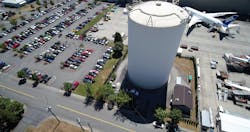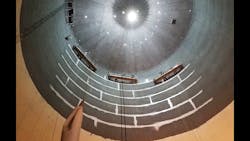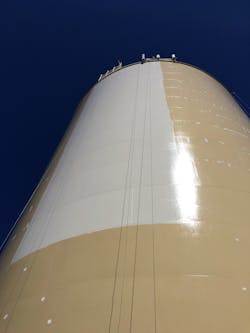Ticktock, ticktock. The 50-day completion clock had just started as a crew from HCI Industrial & Marine Coatings Inc. waited anxiously to begin restoring the 50,000-square-foot interior of a 4.5 million-gallon potable and fire water storage tank. As soon as a local subcontractor finished cutting a temporary access hole in the bottom of the tank, HCI’s crew scrambled to meet the tight deadline. Their readiness paid off, as the Mukilteo Water and Wastewater District (MWWD) was able to return the tank to service 47 days later — three days ahead of schedule — with a fully restored lining designed for long-term service.
Located at Paine Field, the MWWD tank stores potable water for residents in the Mukilteo and South Everett areas north of Seattle. It also serves a critical role as a fire suppression system reservoir for an adjacent aircraft manufacturing facility on the airport grounds. Per a municipal agreement, the tank can only be taken out of service for about eight weeks every three years. Therefore, Brush Prairie, Wash.-based HCI was bound to the tight restoration timeline, facing fines of $3,000 for every day the tank would be out of service beyond 50 days.
Based on the aggressive restoration timeline, Seattle-based consulting engineering firm Gray & Osborne Inc. (G&O) developed a contract specification that promoted quality, safety, and efficiency. G&O’s specification favored speed by stipulating SherPlate PW Epoxy for the interior lining. The edge-retentive, ultra-high solids coating from Sherwin-Williams Protective & Marine can be applied in a single coat and cures quickly, accelerating the tank’s return to service.
“We restored the Paine Field water tank under challenging conditions, including a short, mandatory project window and close proximity to parking and manufacturing areas,” said Randy Cornelius, vice president of HCI. “We were able to complete the project ahead of schedule due to the expertise of our project team leaders as well as the timely support of our subcontractors and suppliers.”
The team on this fast-turnaround project was named a runner-up for the 2017 Sherwin-Williams Impact Award, which honors professionals committed to enhancing water and wastewater infrastructure to improve public health and safety.
Equipment, Coating Choices Accelerate Interior Lining Restoration
With the clock ticking on the return-to-service timeline, HCI’s 12-person crew installed temporary swing stage scaffolding to promote efficiency. This setup allowed eight crew members in the air to easily reach all areas of the structure from top to bottom, with two crew members on the ground tending to pots and hoses, as well as a foreman and a superintendent on site.
HCI also used extensive industrial equipment with large capacities inside the cavernous tank to enable an accelerated project timeline. They banked two 1600-CFM compressors and air driers into a 28-ton, eight-hole abrasive pot with a 32-ton hopper. They also used a 7,000-CFM dehumidifier with 100-kw heater banks. These controls helped HCI manage the relative humidity inside the tank to keep the steel from flash rusting after surface preparation, allowing HCI to coat the interior in large sections to expedite the project.
For the tank lining, crew members first spray- and back-brush-applied a stripe coat of SherPlate PW Epoxy on all weld seams, edges and irregular surfaces to ensure complete coverage. Next, they immediately spray-applied a 25- to 35-mil dry film thickness (DFT) topcoat of the SherPlate system in a single coat for an efficient application.
The SherPlate system’s pot life of seven minutes after mixing also helped with application efficiency, as this extended open time enabled HCI to spray the material 145 feet in the air with minimal worries related to spray guns or hoses clogging from exothermic reactions. The originally specified epoxy lining material had a pot life of just one minute, which prompted HCI to ask G&O to change the specification to give applicators more time to spray.
“Selecting the SherPlate system helped us maintain our project schedule and limit our spraying challenges. When you’re pumping 130° F material 145 feet up to the top of the tank, every second counts, and the extended open time was one of the major driving factors in the decision to use this lining system,” Cornelius said. “In addition, the product’s high film build and edge-retention properties enabled us to apply the liner in a single coat.”
Application Methods Prevent Exterior Overspray
Restoring the tank’s exterior presented HCI with a unique challenge to meet the airport’s FOD management requirements. The team needed to fully contain debris and coating materials to prevent the possibility of damaging new turbine engines being tested at the airplane manufacturing facility. Any debris floating in the air could easily be ingested by the engines during testing. Therefore, G&O and HCI agreed to a combination of isolated containment systems, solvent cleaning surface preparation and manual coating methods.
First, HCI set up a full containment system around the swing stage access platforms used for the exterior restoration. This system, combined with a temporary 6-foot-tall barrier fence HCI installed around the project perimeter, also helped protect nearby vehicles and assets, as a road, parking area and airplane assembly areas border the tank.
Due to the uptime requirements of the water tank, HCI had to reserve the 50-day out-of-service window for the tank interior. That meant HCI had to top coat the tank’s exterior when it was full, which is not ideal due to the potential for condensation and uneven temperatures across the substrate. However, HCI’s high-performance coating selections alleviated any concerns.
Crew Completes Efficient Restoration
Through a combination of careful planning and strategic coatings selections, HCI was able to complete the project ahead of schedule in a streamlined, efficient manner.
“We planned ahead for every step of this project to ensure we could meet the prescribed timelines,” Cornelius said. “Our coating selections, particularly for the interior where we could limit the number of coats to one, helped immensely with staying on schedule.”
MWWD might even realize future efficiency payoffs in terms of reduced life cycle maintenance costs for the tank. The restored tank lining is expected to last more than 20 years, with periodic inspections to be scheduled. Plus, the exterior finish should last beyond 15 years. WW
About the Author
Murray Heywood
Murray Heywood is the North America market manager of water and wastewater for Sherwin-Williams Protective & Marine. He has served the coatings industry for more than 37 years, beginning as an applicator for his father’s coating business and continuing today with his focus on effectively supporting the varied product and service needs of the industry. Heywood holds the Master Coatings Inspector Certificate (MCI) from SSPC, as well as Level 3 Certified Coating Inspector (CIP) certifications from both SSPC and NACE International where he also teaches coating inspection courses. He can be reached at [email protected].



